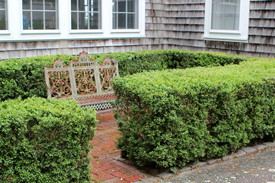 Trimmed and trained hedges accentuate a backyard space. |
Hedges require a particular kind of pruning, which is similar for both deciduous and evergreen. Hedges are kept trimmed to the desired size by shearing all over or by clipping out individual branches. The more vigorously the hedge grows, the more often it will need trimming. It is sensible to plant varieties whose mature size is just a little taller than the desired height of the hedge. Planting a Siberian elm and trying to keep it 6 feet high will be a constant struggle. In Europe, beech trees and other large species are often trained as tall hedges, a practice that began in royal gardens. One does, however, need a staff of royal gardeners to maintain them.
Hedges used to be more popular than they are now. One reason for their downswing is the demise of the hired hand. Trimming hedges is time consuming and costly, despite the introduction of electric hedge clippers. Some hedge plants need cutting only once a year. This includes tamarisk, hawthorn, saltbush, saskatoon, potentilla, winged euonymus and bush honeysuckle. Most blooming hedges should be trimmed only once a year, just after blooming. Then they should be left to grow naturally until the next year. Some examples are forsythia, spirea, spice bush, wigelia, roses and lilacs. They are all vigorous and will grow into nice rounded mounds, about 6 to 9 feet tall.
Some trees, when used as very tall windbreaks or for noise or privacy screening, may also be trimmed only once a year. Examples of such trees include green ash, mossycup oak, coppiced willow, beech and choke cherry. Hedges that need trimming more times per year are privet, cotoneaster, alpine currant, natal plum, barberry, hibiscus, and bouginvillea.
Trimming Tips
When pruning any shrub or hedge, remember that the bottom of the bush will remain green and thick only if it has full light. Most people — even some professional gardeners — prune incorrectly. Healthy hedges should be wider at the bottom than at the top. They should not be round or narrow at the bottom, because the lower leaves will not receive enough light for healthy growth. Eventually the leaves will fall, leaving bare twiggy holes.
When using hedges for windbreaks, intertwined branches break the wind better, so you really need not trim them at all. This makes planning a windbreak much easier. The secret is to choose shrubs that naturally reach the desired height. Then they can be neatened up when require, but will not require constant shearing.
Too many commercial gardeners from the “old school” recommend shrubs that make good hedges must be constantly pruned. They are accustomed to doing it that way and it makes more business for them. Shrubs that withstand constant shearing, of course, must be more vigorous and often larger than the height that is wanted. It becomes a vicious cycle. You’re far better off choosing plants that will serve well at their natural mature size.
The current fascination with European garden design prompts the use of pruned specimen plants, which are necessary to create that formal style. Round or square or pointed shrubs, usually evergreen, are one of the characteristics of royal gardens. Sometimes the plants are pruned to form animals or spirals or other interesting shapes. When the pruning passes from the purely practical to become an art form, it is called topiary. To keep the plants trimmed into their desired shapes requires great skill, patience and frequent light clipping. To those who enjoy it, it is very satisfying.
Required Viewing
Credit: www.mothersgarden.net




























